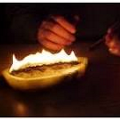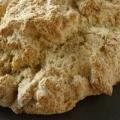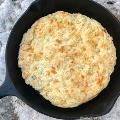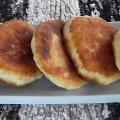
Breaking bread: A brief history of bannock
Thank you, Tina, for taking us out of the fire and into the frying pan! I make a fry-bread version that is individual-sized. I have many memories of “helping” my mom as she slid the thin, flat slabs of dough into the bubbling oil. We ate it with corned beef hash (made from canned corned beef, yes, I know…) or with jam for dessert!
The Basics
There are many versions of bannock and different nations make more than one version. Bannock can be baked in a pan or on a stone (camping), shallow pan-fried, or deep-fried. You can enjoy it with stews or just jam and butter. It was eaten with molasses and pork or pork fat.
Luskinikn (pronounced loo-skin-e-gen), like other bannock, is made from flour, lard, salt, water (or milk). Some use baking powder and some add sugar.
Kcitqihikon (pronounced k’cheet-qway-he-gon) is the Passamaquoddy/Wolastoqey bread cooked on coals.
| Wabanaki Breads | Pronunciation | Type of bread | Nation |
|---|---|---|---|
| Luskinikn | loo-skin-e-gen | Mi’kmaq | |
| Kcitqihikon | K’cheet-KWAY-he-gun | Bread cooked on coals | Passamaquoddy/Wolastoqiyik |
| Tumahsis (derived from the name Tom Francis) | Too-MAH-sis | Fry bread | Passaquamoddy |
| lakalet, akalet | La-GAH-ledt | Fry bread | Wolastoqiyik |
Make your own
Joni Simon’s Losgenigen (Luskinikn)
Joni is an IT Technician at our Moncton Campus. She has worked with NBCC for 17 years.
Ingredients:
1 cup flour
1 tsp. baking powder
½ tsp. salt
Warm water
I vary the recipe to the size that I want. I typically double it or triple the amount to make a big pan of it. I fry it in a frying pan with oil (1/4 cup) on low to medium heat. Once it’s cooked on one side, I flip it (very carefully) and cover the pan. I sometimes add more oil to the pan, depending on how much is left. Once it’s golden brown, it is ready! - Joni
Tina Brewer’s Bannock on a Stick (when she was a wee girl in the Guides)
Tina is an Executive Assistant at our Corporate Office
Blend together:
2 c. all purpose flour
4 t. baking powder
1 t. salt
Cut in finely: 1/3 c. shortening
Add: 3/4 c. PLUS 2 Tablespoons milk
Stir with a fork to make a soft dough. Knead gently 8 to 10 times on a lightly floured surface. For use as bannock I made the dough a tiny bit drier so it would be easier to mold onto the cooking stick. We would cook it on the end of a stick over the open camp fire and then eat with butter, jam, ect inside the hollow.
Other resources
- Mi’kmaq Mama’s “how to” video shows both baked and fried Luskinikn:
| Bannock from other Nations | Bread name | |
|---|---|---|
| Inuit | Palauga or muqpauyug | Made over a quilliq seal oil lamp |
| Ojibwa | Ba‘wezhiganag | |
| Coast Salish (Beecher Bay) | Sapli’l (ground camas bulbs) | |
| Nehiyawak (Cree) | Has currants and/or raisins | |
| Metis | La galette, galette de michif or les baigne |
A Deeper Look
We were obliged to gather moss, called in the Indian tongue, wahkoonun, ‘from the rocks’. This moss we boiled, which becomes very slimy, but which possessed some nourishing qualities. On this we lived for several days...
A controversial history
As delicious as it is, bannock is not without controversy! Did it come from Scotland? Was it here before settlers came from Europe? The word “bannuch” is Gaelic for “morsel” and Selkirk Scottish explorers survived on stone-baked peameal, oatmeal or barleymeal bannuch in the 18th century. The common story is that these explorers shared their recipes with local Indigenous nations and bannock was introduced.
Apart from its origin controversy, Bannock as we know it today, represents a time when Indigenous peoples were forced off the land and forced to eat new foods. As nomadic communities were moved from their hunting and trapping grounds onto reserves, their food supply now came from Canada in the form of rations. Wheat flour was introduced in the late 19th century and became a staple. Some credit this rapid diet change with the rise of diabetes in Indigenous Peoples.
The big “but” - Bannock before European contact
While the origins of bannock as we think of it today remain controversial, it is important to note that Indigenous nations across the country made many different forms of breads prior to Contact. These were typically unleavened breads which were made from the starch or flour of the underground stems of ferns, ground maize, ground roots or bulbs, lichens, mosses, cat-tail pollen, etc. They were cooked in open fires, on rocks, in sandpits, and vessels.
Resources
- The Canadian Encyclopedia offers a detailed general history of bannock
- Listen to CBC’s Unreserved episode Bannock: a brief history
- Bannock Awareness history pamphlet by Michael Blackstock (2013) includes 27 different Bannock recipes including some pre-contact
- Indigenous peoples and diabetes by M. L. Ferreira & G. C. Lang (2005)
- Bannock Bread (Métis recipe)
- Bannock recipe: How to make a northern staple (Inuvik recipe)

.tmb-thumbnail.jpg?Culture=en&sfvrsn=46ee5854_1)




